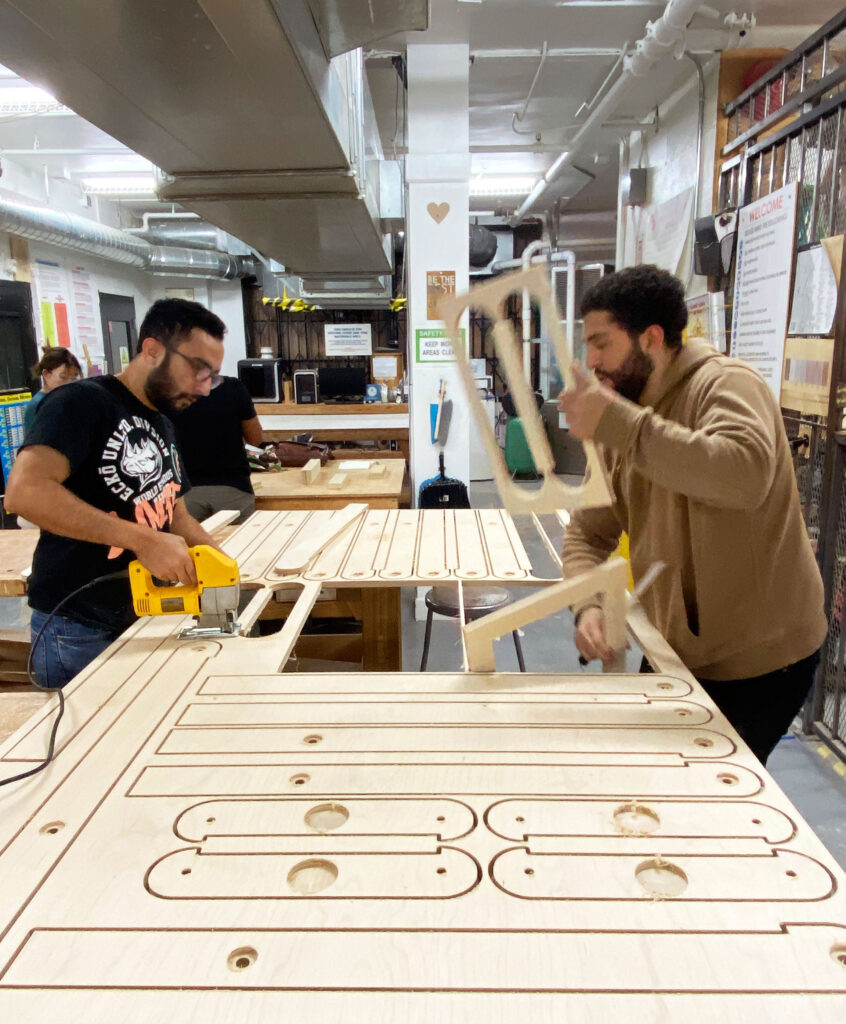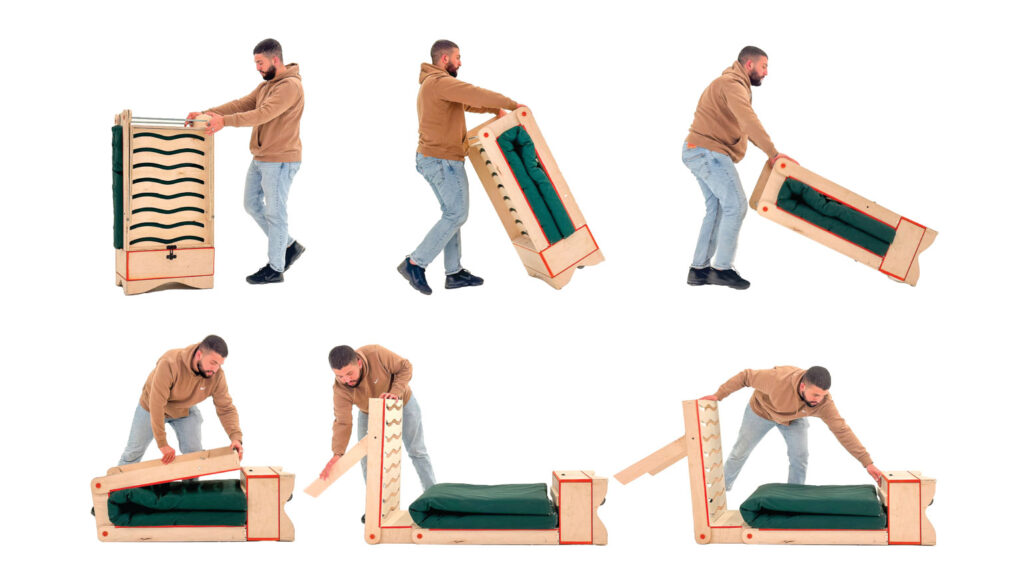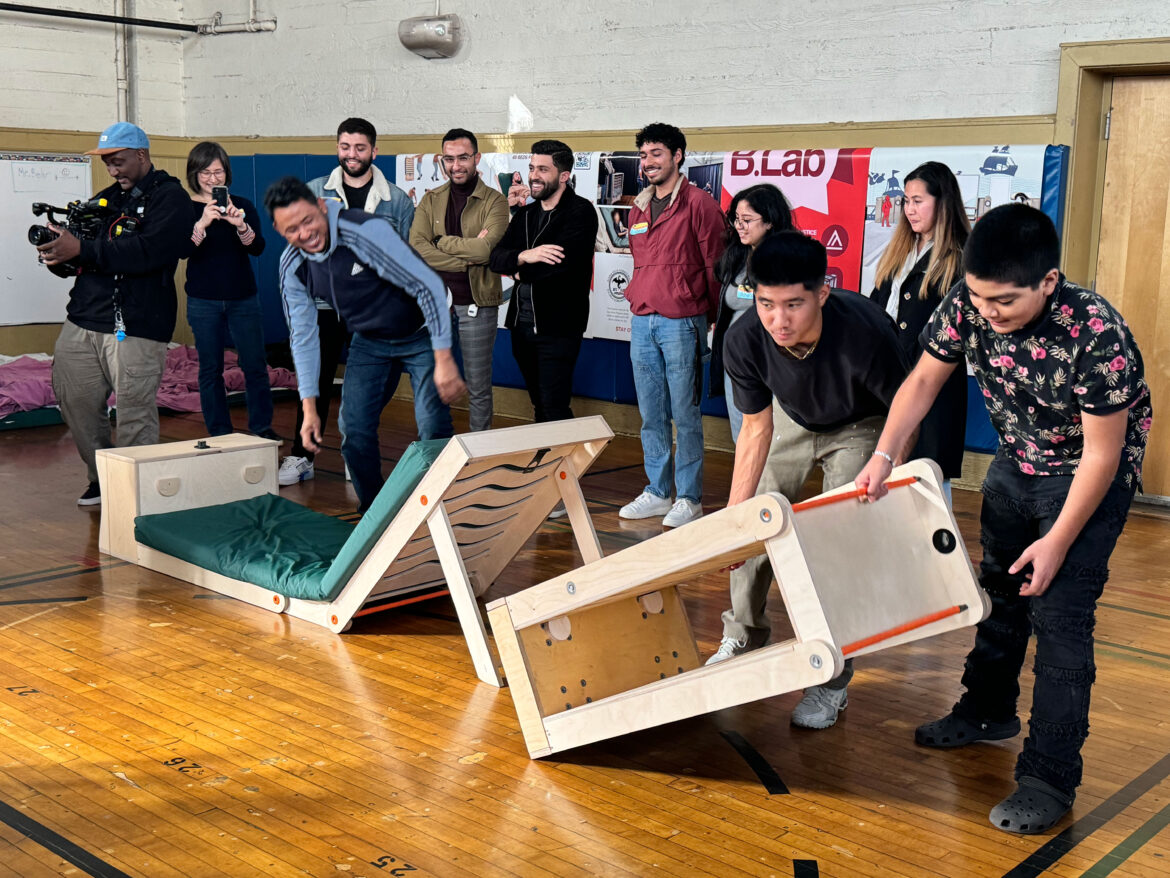By Rachel Reyna
It is no secret that COVID-19 had some detrimental effects on San Francisco, negatively affecting the city’s unhoused population. Academy of Art University’s School of Architecture (ARH) students and faculty, through the ARH 498 series, have found ways to help this San Francisco community using their knowledge, skills, and resources.
ARH 498 is part of the B.lab community-based design-build program within ARH, which promotes spatial justice for local communities and advocacy for future designers.
ARH students and faculty collaborated with the Stay Over Program, an emergency family shelter that is set up every night at 7 p.m. and taken down every morning at 7 a.m. The shelter is held in the Buena Vista Horace Mann K–8 gymnasium. Congregate family shelters like these are for families with no other temporary housing options.

“I got involved with this project because I introduced them—the nonprofit and the shelter—to the school,” said Seong. “I heard about it through a personal volunteer role and came across it and then understood the challenges of operating an emergency shelter in a space that’s not designed to be a shelter; I just felt like this is a perfect client for our 498 Series class.”
Upon learning about the program, the students working on the project—many of whom were in their final year at the Academy—began brainstorming ways to improve the shelter’s conditions.
“They told us about the scope of the project and what kind of community we would be dealing with, and I found it interesting to have a real-life experience, to deal with real people and have a real problem to solve instead of just having conceptual ideas,” said Mohamed Meawad, 2023 ARH M.A. alum.
The students felt it was important that the families who stayed in the shelter had some sense of ownership over their space. Before the ARH students began this project, families at the shelter were using different bed pads every night. Ownership over one’s property instills a sense of dignity and autonomy, which the students felt was a principal mission of their project. It was also crucial to the students that the families were involved in the project’s creation in order to produce the best and most effective results.
With the emergency center held in a school gym, the students considered the program’s quick turnaround as they worked with families to determine what they could improve upon based on their needs.
“We did a lot of iterations; we worked with the families, and during that, we had multiple community workshops and listened to their needs. We did surveys to see what they need, not what we think they need,” said Lowai Ghaly, a 2023 ARH alum and project lead. “And that’s how we came up with the idea of the bed.”

“We showed [the design] to the family, and then we heard feedback from the families. [T]hey were impressed with the design of the bed, but they had a couple of comments about safety. The ease of the process for folding or unfolding the bed,” said Meawad. “So, we listened to them, we started thinking about the solution, and we found that solution. Then, we started doing another prototype. Then, we did another community workshop that introduced the final prototype. The family was happy with it, and we started the final production for the whole thing.”
The beds were mainly made from plywood and were designed with the intention of swift setup and breakdown. They can be folded and have wheels to maneuver easily. The beds also have the capacity to store the families’ belongings, creating space and security for temporary residents and staff.
The beds spent about a year in the collaboration and creation process. Faculty and Undergraduate Program Director Karen Seong, co-faculty Sameena Sitabkhan, and ARH students detailed the collaborative process and the importance of micro-intervention and co-creation in a paper accepted to the Association of Collegiate Schools of Architecture, Disrupters on the Edge Conference.
“Micro-interventions can powerfully disrupt the systems that preclude an empowering experience in family shelters,” they wrote. “Through co-creation, families can actively participate in the design research process.”
Not only did the project allow the students to give back to the Stay Over Program, but it also provided an opportunity for them to build out their technical and service skills in a real-world setting.
“The instructors, like Karen and Sameena, were great,” said Ghaly. “They were pushing us to do more all the time and giving us space, so it felt like we were working in an office. They were just kind of watching us from far away and giving each person a role, and they were basically just letting us do all the work and managing all the stuff, for example, ordering materials. We had to do it ourselves. And it was great just giving us this opportunity to feel how it will be in the real world before we even get into the real world.”

“There are just too many dire problems within all our communities across the country, across the world,” said Seong. “And so, it feels indulgent to ignore that and to put up your walls and keep the status quo when often it feels like the world outside is falling apart. There are so many people who need help. To have an actual impact in helping somebody else, I think that’s really rewarding for [the students], and that’s a good trajectory for their career after school.”
Many flourishing and well-funded universities across the United States are located in cities where the local communities struggle with things like food insecurity, housing crises, and wealth disparities. The ARH students explained that they feel a responsibility to the community surrounding the Academy’s campus throughout the city of San Francisco.
“How many school gyms are in the Bay Area that are not used that night? It could be transformed to solve millions of issues. So all that money and effort that they’re putting into creating architecture that is anti-homeless could be used to create spaces like the ones that [we worked in],” said Lowai when speaking about combating anti-homeless architecture with feasible solutions using the skills that they learned at the Academy.
Students also spoke about their post-graduation plans. Their participation in aiding the Stay Over Program has inspired them to continue community service through architecture.
“For me and my classmates, we started to think about starting our own architecture firm, and we did start; we’re still in the process,” revealed Meawad. “But when we started talking with each other about the structure of the firm and the scope of work we would be targeting, one of them was for the community. That will be the volunteering part of our time to design for the community or to serve the community because it feels like we owe this to the people to be educated, especially in architecture, which is one of the main things that serve people.”
“My plan in the future is to start my own firm, do things that are for-profit, and have a section where we also do nonprofit stuff like the beds we did,” shared Ghaly. “Maybe just going on the streets and seeing what people need, trying to figure out a solution for them, and giving it out for free. And getting people to invest in that idea if it’s helpful for the community and just getting it out there.”
